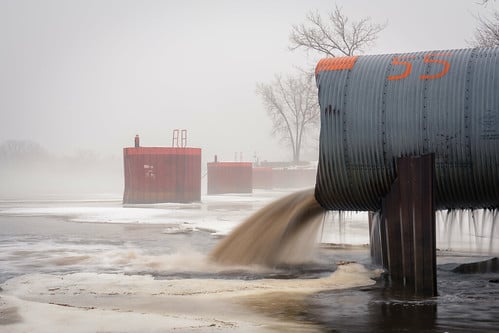The Clean Water Act (CWA) requires the Environmental Protection Agency (EPA) to define “oil” and “hazardous substances”, and includes requirements that EPA establish “procedures, methods, and equipment and other requirements for equipment to prevent discharges of oil and hazardous substances from vessels and from onshore facilities and offshore facilities, and to contain such discharges….” (33 USC § 1321(j)(1)(C)) Since 1973, EPA has required owners and operators of non-transportation-related onshore and offshore facilities to establish and implement Spill Prevention, Countermeasure and Control (SPCC) Plans if they manage more than threshold levels of oils (I summarized these requirements here).
Read MoreAudit, Compliance and Risk Blog
Jon Elliott
Recent Posts
EPA Decides Not to Require SPCCs to Address Hazardous Substance Spills
Posted by Jon Elliott on Tue, Sep 24, 2019
Tags: Environmental risks, Environmental, EHS, EPA, Hazcom, effluent, Stormwater, clean water, spcc
DC Circuit Upholds Most of EPA’s 2015 Standards For Ground Level Ozone
Posted by Jon Elliott on Tue, Sep 17, 2019
On August 23, the federal Court of Appeals for the District of Columbia (DC Circuit) upheld most aspects of the National Ambient Air Quality Standards (NAAQS) for ground level ozone adopted by the Environmental Protection Agency (EPA) in 2015. The Clean Air Act (CAA) requires EPA to create a list of air pollutants based on emissions that cause or contribute to air pollution that may reasonably be anticipated to endanger public health or welfare (criteria pollutants), to establish NAAQS based on these criteria, and to review the NAAQS every 5 years.
Read MoreTags: Business & Legal, Health & Safety, Environmental risks, Environmental, EPA, Greenhouse Gas, ghg, CAA
EPA Proposes to Allow Hazardous Air Pollutant Sources to Reclassify From “Major” to “Area” Using Administrative Controls
Posted by Jon Elliott on Tue, Sep 10, 2019
The Clean Air Act (CAA) directs the Environmental Protection Agency (EPA) to define “hazardous air pollutants (HAPs)” that may pose acute health hazards, and to impose regulations to reduce those hazards. EPA requires permits for “major sources” of HAPs based on “Maximum Achievable Control Technologies (MACT),” and lesser controls for non-major “area sources.” Since the Trump Administration took office, EPA has pursued several initiatives to make it easier for sources to reclassify from “major” to “area” in order to reduce their regulatory responsibilities. For example, in January 2018 EPA ended a decades-old policy declaring that every emission source that met major source criteria at the time a MACT became effective was “once in, always in” and could not requalify as a less-regulated area source by accepting legally binding controls that reduce its “potential to emit (PTE).” (I wrote about this change here).
Read MoreTags: Health & Safety, Environmental risks, Environmental, EPA, Greenhouse Gas, ghg, Hazcom, Oil & Gas
Reversed on Appeal: Workplace Harassment Isn’t a Tort In Ontario After All
Posted by Jon Elliott on Tue, Sep 03, 2019
Although an ever-expanding range of laws prohibit workplace harassment, the Court of Appeal for Ontario has now ruled that harassment is not a free-standing common law tort in that province. This ruling reverses a trial court ruling by the by the provincial Superior Court of Justice that shocked employment law in 2017. This ruling returns workplace harassment to the realm of statutory and regulatory requirements and prohibitions, which certainly isn’t unambiguous, but at least offers more structured frames of reference. The case is Merrifield v. Canada (Attorney General), and it litigates a complaint between a member of the Royal Canadian Mounted Police (RCMP) and his employers.
Read MoreTags: Business & Legal, Employer Best Practices, Employee Rights, Workplace violence, Canadian
Motor Vehicle Greenhouse Gas Standards–California and Four Manufacturers Finesse the Turf War With the Federal Government
Posted by Jon Elliott on Tue, Aug 20, 2019
Since the Trump Administration reversed the federal government’s agreement with California for joint motor vehicle greenhouse gas (GHG) standards, federal and state agencies have moved steadily to assert their respective authorities and to sue their counterparts. However, on July 25, 2019 California and 4 major vehicle manufacturers announced a voluntary agreement that eases the state requirements somewhat while making the looser federal standards irrelevant for those companies – and for any additional manufacturers that might join later.
Read MoreTags: Business & Legal, California Legislation, Environmental risks, Environmental, Greenhouse Gas, ghg
Although workplace air quality concerns usually focus on contaminants produced by workplace activities, this summer’s wildfire season provides a reminder that unsafe workplace air may also enter from outside and offsite. On July 18, California’s Occupational Safety and Health Standards Board adopted an emergency rule (8 CCR 5141.1) requiring worker protection from wildfire-produced bad air, which the state’s Division of Occupational Safety and Health (Cal/OSHA) began to enforce effective July 29. In California, you should prepare to comply; if you work someplace else but could be affected by wildfires then this rule provides a useful basis for approaching the issue.
Read MoreTags: Health & Safety, OSHA, Employee Rights, California Legislation, Environmental risks, Environmental, EPA
The Environmental Protection Agency (EPA) has just issued rules that repeal and replace one of the Obama-era EPA’s signature efforts to reduce greenhouse gas (GHG) emissions. Effective September 6, EPA’s new “Affordable Clean Energy Rule” (ACE) will replace the “Clean Power Plan” adopted in 2015 but stayed by litigation (I wrote about the proposed CPP here). As anyone who has compared the Obama and Trump Administrations' approaches to climate change would expect, the new rule reduces the old rule’s requirements. It softens the mandates in the earlier rule, and offers states more flexibility to design their own efforts to control GHG emissions from existing fossil fuel-fired electricity generating units (EGUs) by eliminating CPP requirements that states consider operational changes “outside the fenceline” of the regulated EGUs.
Read MoreTags: Environmental risks, Environmental, EPA, Greenhouse Gas, ghg
Reporting EHS Releases – Responsibilities Continue Except For Some Farm Emissions
Posted by Jon Elliott on Tue, Jul 16, 2019
Among its many provisions, the Emergency Planning and Community Right-To-Know Act of 1986 (EPCRA, in this case Section 304) requires facilities to report releases of specified hazardous and extremely hazardous substances, if the release exceeds an applicable threshold reportable quantity (RQ). The Environmental Protection Agency (EPA) administers these requirements, and has just approved an exemption for emissions from animal wastes at farms (this exemption tracks one amended into the Superfund law (CERCLA) in 2018). Other types of facilities and activities are still subject to these reporting requirements, so it’s a good time to review them.
Read MoreTags: Health & Safety, Environmental risks, Environmental, EHS, EPA, Greenhouse Gas, ghg, Hazcom
Since President Trump took office, the Environmental Protection Agency (EPA) has taken a number of steps to narrow benefit-cost analyses, reversing expansive approaches used during the Obama Administration and narrowing the scope of “justifiable” environmental and health regulations. The latest such step appears in a May 13 memorandum from EPA Administrator Wheeler to his Assistant Administrators.
Read MoreTags: Business & Legal, Environmental risks, Environmental, EHS, EPA
Status of Trump Administration Environmental Regulatory Rollbacks
Posted by Jon Elliott on Tue, Jul 02, 2019
Since President Trump took office, I’ve written in this space a number of times describing specific executive and regulatory initiatives to freeze or reverse environmental regulations. They’ve largely conformed with the President’s antipathy for such regulations, and his appointees’ vigor. Environmental and health advocates have challenged all these changes, continuing to yield court decisions confirming the limits of executive and administrative authority to impose changes (In January 2017 I summarized the limits on various approaches here).
Read MoreTags: Health & Safety, Environmental risks, Environmental, EPA, Oil & Gas, clean water










